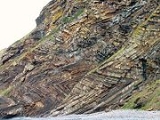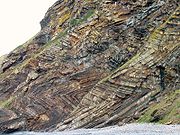
Killas
Encyclopedia
Killas is a Cornish
mining
term for metamorphic rock
strata
of sedimentary origin which were altered by heat from the intruded granites in Devon
and Cornwall
, England
. The term is used in both Devon and Cornwall.
and Carboniferous
geological periods. The sediment
s are not evenly spread over the county, with the Carboniferous beds being only found in the far north of Cornwall.
The depositional environments of the killas were very varied, as is revealed by the fossil
content and the sedimentary sequences. The fossils indicate changes from anaerobic, deep ocean-basin environments to shallow sea environments. The well-known Delabole Butterfly formation was found in the upper Devonian beds of North Cornwall.
 Shortly after the deposition of the sediments, the Variscan orogeny
Shortly after the deposition of the sediments, the Variscan orogeny
caused the intrusion of the Cornish granites and the subsequent contact metamorphism created the metamorphic rocks seen today. This also put intense pressure on the sediments causing them to be folded
and faulted
. This is most apparent in the cliffs at Millook Haven on the north Cornwall coast, where the cliffs display an impressive series of angular recumbent folds.
in Devon, and as a result of hydrothermal mineralization from the granites, contain the majority of the mineral lode
s or veins
which at one time provided up to half of the world's tin
and copper
, and economic prosperity to Cornwall (and to a lesser extent Devon). Of lesser economic importance, the stone itself is an important building and roofing stone in Cornwall, the largest single source in the county being Delabole
slate quarry, which has provided a high quality stone for at least six centuries.
Cornish language
Cornish is a Brythonic Celtic language and a recognised minority language of the United Kingdom. Along with Welsh and Breton, it is directly descended from the ancient British language spoken throughout much of Britain before the English language came to dominate...
mining
Mining
Mining is the extraction of valuable minerals or other geological materials from the earth, from an ore body, vein or seam. The term also includes the removal of soil. Materials recovered by mining include base metals, precious metals, iron, uranium, coal, diamonds, limestone, oil shale, rock...
term for metamorphic rock
Metamorphic rock
Metamorphic rock is the transformation of an existing rock type, the protolith, in a process called metamorphism, which means "change in form". The protolith is subjected to heat and pressure causing profound physical and/or chemical change...
strata
Stratum
In geology and related fields, a stratum is a layer of sedimentary rock or soil with internally consistent characteristics that distinguish it from other layers...
of sedimentary origin which were altered by heat from the intruded granites in Devon
Devon
Devon is a large county in southwestern England. The county is sometimes referred to as Devonshire, although the term is rarely used inside the county itself as the county has never been officially "shired", it often indicates a traditional or historical context.The county shares borders with...
and Cornwall
Cornwall
Cornwall is a unitary authority and ceremonial county of England, within the United Kingdom. It is bordered to the north and west by the Celtic Sea, to the south by the English Channel, and to the east by the county of Devon, over the River Tamar. Cornwall has a population of , and covers an area of...
, England
England
England is a country that is part of the United Kingdom. It shares land borders with Scotland to the north and Wales to the west; the Irish Sea is to the north west, the Celtic Sea to the south west, with the North Sea to the east and the English Channel to the south separating it from continental...
. The term is used in both Devon and Cornwall.
Origin of killas
The deposition of the killas strata is spread over the DevonianDevonian
The Devonian is a geologic period and system of the Paleozoic Era spanning from the end of the Silurian Period, about 416.0 ± 2.8 Mya , to the beginning of the Carboniferous Period, about 359.2 ± 2.5 Mya...
and Carboniferous
Carboniferous
The Carboniferous is a geologic period and system that extends from the end of the Devonian Period, about 359.2 ± 2.5 Mya , to the beginning of the Permian Period, about 299.0 ± 0.8 Mya . The name is derived from the Latin word for coal, carbo. Carboniferous means "coal-bearing"...
geological periods. The sediment
Sediment
Sediment is naturally occurring material that is broken down by processes of weathering and erosion, and is subsequently transported by the action of fluids such as wind, water, or ice, and/or by the force of gravity acting on the particle itself....
s are not evenly spread over the county, with the Carboniferous beds being only found in the far north of Cornwall.
The depositional environments of the killas were very varied, as is revealed by the fossil
Fossil
Fossils are the preserved remains or traces of animals , plants, and other organisms from the remote past...
content and the sedimentary sequences. The fossils indicate changes from anaerobic, deep ocean-basin environments to shallow sea environments. The well-known Delabole Butterfly formation was found in the upper Devonian beds of North Cornwall.

Variscan orogeny
The Variscan orogeny is a geologic mountain-building event caused by Late Paleozoic continental collision between Euramerica and Gondwana to form the supercontinent of Pangaea.-Naming:...
caused the intrusion of the Cornish granites and the subsequent contact metamorphism created the metamorphic rocks seen today. This also put intense pressure on the sediments causing them to be folded
Fold (geology)
The term fold is used in geology when one or a stack of originally flat and planar surfaces, such as sedimentary strata, are bent or curved as a result of permanent deformation. Synsedimentary folds are those due to slumping of sedimentary material before it is lithified. Folds in rocks vary in...
and faulted
Geologic fault
In geology, a fault is a planar fracture or discontinuity in a volume of rock, across which there has been significant displacement along the fractures as a result of earth movement. Large faults within the Earth's crust result from the action of tectonic forces...
. This is most apparent in the cliffs at Millook Haven on the north Cornwall coast, where the cliffs display an impressive series of angular recumbent folds.
Economic uses of killas
Killas underlies two thirds of Cornwall and on and around DartmoorDartmoor
Dartmoor is an area of moorland in south Devon, England. Protected by National Park status, it covers .The granite upland dates from the Carboniferous period of geological history. The moorland is capped with many exposed granite hilltops known as tors, providing habitats for Dartmoor wildlife. The...
in Devon, and as a result of hydrothermal mineralization from the granites, contain the majority of the mineral lode
Lode
In geology, a lode is a deposit of metalliferous ore that fills or is embedded in a fissure in a rock formation or a vein of ore that is deposited or embedded between layers of rock....
s or veins
Vein (geology)
In geology, a vein is a distinct sheetlike body of crystallized minerals within a rock. Veins form when mineral constituents carried by an aqueous solution within the rock mass are deposited through precipitation...
which at one time provided up to half of the world's tin
Tin
Tin is a chemical element with the symbol Sn and atomic number 50. It is a main group metal in group 14 of the periodic table. Tin shows chemical similarity to both neighboring group 14 elements, germanium and lead and has two possible oxidation states, +2 and the slightly more stable +4...
and copper
Copper
Copper is a chemical element with the symbol Cu and atomic number 29. It is a ductile metal with very high thermal and electrical conductivity. Pure copper is soft and malleable; an exposed surface has a reddish-orange tarnish...
, and economic prosperity to Cornwall (and to a lesser extent Devon). Of lesser economic importance, the stone itself is an important building and roofing stone in Cornwall, the largest single source in the county being Delabole
Delabole
Delabole is a large village in north Cornwall, England, UK. It is situated approximately two miles west of Camelford.The village of Delabole came into existence in the 20th century; it is named after the Delabole Quarry. There were three hamlets: Pengelly, Medrose and Rockhead...
slate quarry, which has provided a high quality stone for at least six centuries.

